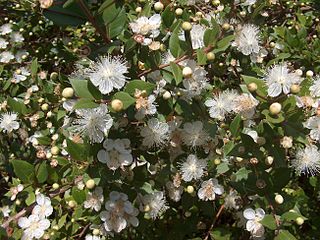
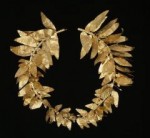
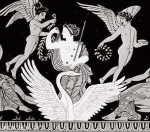
Month: September 2012
The Sacred Fruit of Persephone
September 21, 2012 The autumn equinox coincides with the start of the major ceremonies of the Eleusinian mysteries. These ceremonies, which in Greco-Roman times attracted a huge number of attendees from all over the Mediterranean, guide participants into a deeper understanding of Persephone’s descent into the underworld. There are several versions of the myth of Persephone, which is too long to explain in detail here. The gist of it is that Persephone as a maiden goddess or “Kore” is painting flowers in a meadow when the earth opens up and the death god Hades abducts her. He demands that she stay in the underworld with him as his wife and queen and refuses to let her leave. Persephone’s mother Demeter is inconsolable and neglects her duties as mother of vegetation, leaving crops to wither from lack of rain. As the earth becomes more and more parched, the gods become alarmed, and finally the chief god Zeus orders Hades to relinquish his captive. Unfortunately Persephone has eaten a pomegranate seed while in the underworld, and the laws there decree that no one who takes food in the land of the dead may return to the living. Given the urgency of the situation, a compromise is nevertheless reached: Persephone will spend four months of every year in the underworld with Hades and will spend the rest of her time on earth with her mother Demeter. From Apollodorus:
The autumn equinox coincides with the start of the major ceremonies of the Eleusinian mysteries. These ceremonies, which in Greco-Roman times attracted a huge number of attendees from all over the Mediterranean, guide participants into a deeper understanding of Persephone’s descent into the underworld. There are several versions of the myth of Persephone, which is too long to explain in detail here. The gist of it is that Persephone as a maiden goddess or “Kore” is painting flowers in a meadow when the earth opens up and the death god Hades abducts her. He demands that she stay in the underworld with him as his wife and queen and refuses to let her leave. Persephone’s mother Demeter is inconsolable and neglects her duties as mother of vegetation, leaving crops to wither from lack of rain. As the earth becomes more and more parched, the gods become alarmed, and finally the chief god Zeus orders Hades to relinquish his captive. Unfortunately Persephone has eaten a pomegranate seed while in the underworld, and the laws there decree that no one who takes food in the land of the dead may return to the living. Given the urgency of the situation, a compromise is nevertheless reached: Persephone will spend four months of every year in the underworld with Hades and will spend the rest of her time on earth with her mother Demeter. From Apollodorus: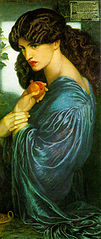
When Zeus commanded Pluto [Hades] to send Core [Kore] back up, Pluto gave her a pomegranate seed to eat, as assurance that she would not remain long with her mother. With no foreknowledge of the outcome of her act, she consumed it… Persephone was obliged to spend a third of each year with Pluto, and the remainder of the year among the gods.
Persephone’s return to the upper world in February coincides with the lesser ceremonies of Eleusis.In addition to explaining the fallow period of the agricultural year, Persephone’s myth is believed to be an account of the merger of the Hellenic (Indo-European) pantheon with a much older one. The rape motif in the story underscores that the Hellenic takeover was a violent one that wrested power from women. In the words of Robert Graves, “It refers to male usurpation of the female agricultural mysteries in primitive times.”The pre-patriarchal Persephone was probably a triple goddess, with the maiden Kore her manifestation in early spring, the mother Demeter her mature aspect, and the queen of the underworld her death aspect. Note that Mediterranean goddesses were rarely depicted as hags or crones, even in their death aspect.Persephone’s symbols are many, but we are confining our attention here to the pomegranate. This tree, which is native to Afghanistan and surrounding regions, has been cultivated for at least 5000 years. It is probable that the fruit was traded even earlier, since pomegranates keep well and their flavor is enhanced during storage. Pomegranate trees grow easily from seed. They thrive in hot, semi-arid conditions, even in poor soil. After the pomegranate flowers, the burgeoning fruit has a pronounced crown. The fleshy red seeds are sectioned by membranes that are cavernous in appearance. The cave is a symbol of both the underworld and the womb. Red is the color of blood, the womb, and birth. Many ancient people in the Mediterranean and elsewhere painted dead bodies with the red mineral ocher to symbolize rebirth. Of course, seeds also symbolize birth, and the plethora of seeds inside the pomegranate make it an emblem of fertility.Provocative symbolism aside, the pomegranate is a useful fruit. The seeds have a pleasant, astringent taste that is not overly sweet. The seeds have long been used to treat tapeworms, and the rind can sooth irritated skin. The rind is also used to dye cloth yellow. The sacred trees of major goddesses usually have a long history of generosity to humans.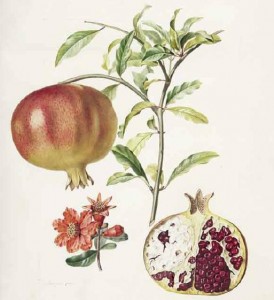
The Broom is Married to the House
September 14, 2012 In pagan imagery, the broom is not just a symbol of witches, but of wives. The Celtic goddess Brigid has among her many functions the charge of housekeeping, and her followers report that they often see her with broom in hand. Women used to leave their broom outside the front door when they left the house, as a signal to visitors that they were not at home. The ordinary broom used for household chores, as opposed to the witch’s ritual broom, is married to the house; when a family moves it is customary for the broom to remain at the house rather than being brought along to the new location.Many people are familiar with the phrase “to jump the broom,” which means to get married, and this custom relates to the broom as symbol of housekeeping and mature womanhood. The custom of jumping the broom was common on the American frontier when ordained ministers were scarce. A couple might be awaiting their second child before their marriage became official within their church, and the broom served to sanction their union until then. Broomstick weddings were also common among African American slaves, who were denied “real” marriage by slaveholders and Christian authorities. The association of brooms and marriage has antecedents in so many cultures that it is impossible to trace the origin of the custom, other than to say that it almost certainly did not originate in America.In many pagan weddings today, it is the jumping of the broom, rather than the exchange of rings or the words “I do,” that is the core part of the ceremony. The couple, holding hands or with hands fastened by ribbons, jumps over a broom lying horizontal on the ground. While in the air the spirits of the couple become joined, and when they hit the ground that union becomes sealed in the physical world. Superstitions about broom handles touching the ground suggest that in the older ceremonies the jumping broom might have been elevated or propped against something.
In pagan imagery, the broom is not just a symbol of witches, but of wives. The Celtic goddess Brigid has among her many functions the charge of housekeeping, and her followers report that they often see her with broom in hand. Women used to leave their broom outside the front door when they left the house, as a signal to visitors that they were not at home. The ordinary broom used for household chores, as opposed to the witch’s ritual broom, is married to the house; when a family moves it is customary for the broom to remain at the house rather than being brought along to the new location.Many people are familiar with the phrase “to jump the broom,” which means to get married, and this custom relates to the broom as symbol of housekeeping and mature womanhood. The custom of jumping the broom was common on the American frontier when ordained ministers were scarce. A couple might be awaiting their second child before their marriage became official within their church, and the broom served to sanction their union until then. Broomstick weddings were also common among African American slaves, who were denied “real” marriage by slaveholders and Christian authorities. The association of brooms and marriage has antecedents in so many cultures that it is impossible to trace the origin of the custom, other than to say that it almost certainly did not originate in America.In many pagan weddings today, it is the jumping of the broom, rather than the exchange of rings or the words “I do,” that is the core part of the ceremony. The couple, holding hands or with hands fastened by ribbons, jumps over a broom lying horizontal on the ground. While in the air the spirits of the couple become joined, and when they hit the ground that union becomes sealed in the physical world. Superstitions about broom handles touching the ground suggest that in the older ceremonies the jumping broom might have been elevated or propped against something.
Frigga and the Birch
September 7, 2012



